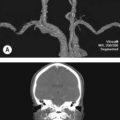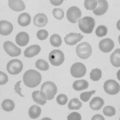216 Swollen leg I
Deep vein thrombosis
Salient features
History
• Recent history of immoblization including recent surgery, stroke, myocardial infarction
• Whether onset was acute or chronic
• Past and family history of thromboses including deep vein thrombosis (DVT), pulmonary embolism
• Drug history: oral contraceptives
• Air travel; the evidence is circumstantial (BMJ 2001;322:188).
Examination
• Unilateral swollen leg with pitting oedema (Fig. 216.1)
• Pain on the calf on dorsiflexion of the foot: Homans’ sign (not diagnostic).

Fig. 216.1 Deep venous thrombosis: acutely swollen left leg with dilation of the superficial veins.
(With permission from Forbes, Jackson 2003.)
• Check for pitting oedema on both sides (look at the patient’s eyes while eliciting this sign to ensure that you are not hurting the patient).
• Compare the temperature of both the legs (use the dorsum of your fingers to elicit this sign).
• Check the arterial pulses in the leg.
• Comment on the heparin pump by the bedside.
• Remember to collect your thoughts when asked to examine the legs: do not rush in to grab the patient’s legs.
Questions
What are the predisposing factors for venous thrombosis?
• Surgery (particularly of leg or pelvis, or after prostatectomy)
• Following cerebrovascular accident (about half of the patients develop DVT)
• Following myocardial infarction (one-third of patients have DVT)
• Malignancy (Lancet 1998;351:1077–80)
• Older age (exponential increase above the age of 50 years)
• Immobilization (paralysed limbs in stroke, paraplegia)
• Previous DVT (risk increases two- to three-fold)
• Pregnancy (risk increased in postpartum period)
• Hypercoagulable states: antithrombin III deficiency, protein C deficiency, protein S deficiency, antiphospolipid syndrome, excessive plasminogen activator inhibitor, polycythaemia vera, erythrocytosis
How would you treat patients with below-knee thrombi?
How would you treat patients with above-knee thrombi?
All patients with thrombi above the knee must receive anticoagulation therapy:
• Low-molecular-weight heparin has been shown to be more effective than unfractionated heparin in reducing size of thrombus and prevention of recurrence. It requires subcutaneous injection but does not require bolus or laboratory monitoring. Examples include enoxaparin, dalteparin or tinzaparin.
• Parenteral synthetic pentasaccharide analogues (e.g. fondaparinux) are factor Xa inhibitors that can also be used as first-line therapy.
• Unfractionated heparin is preferred in patients with iliofemoral thrombosis:
Remember: Anticoagulants do not affect thrombus that is already present.
• When anticoagulation is contraindicated, inferior vena caval filters may be required when there is a high risk of pulmonary embolism.
• Thrombolysis should be considered when the thrombosis is ‘limb threatening’.
There is no consensus on duration of therapy but the following are broad guidelines:
How would you prevent deep venous thrombosis?
• Subcutaneous low-dose heparin or low-molecular-heparin should be given to patients:
• Stop oral contraceptives prior to surgery
• Early ambulation within 72 h after surgery
• Encourage leg exercise following surgery
• Elastic supports to patients with a history of thrombosis or obesity
• Aspirin 160 mg every day reduces the risk of pulmonary embolism and DVT by at least a third particularly after hip surgery (Lancet 2000;355:1295–302).
Advanced-level questions
How is bleeding risk from warfarin calculated?
The HEMORR2HAGES score is computed by adding 1 point for each bleeding risk factor:
Reduced platelet count (<75 × 109/l) or function
Rebleeding risk (2 points for major bleed and 1 point for minor bleed)
The risk of bleeding is then predicted by the following table (Am Heart J 2006;151:713–19):
| Hemorr2hages score | Bleeds per 100 patient-years warfarin (95% confidence interval) |
|---|---|
| 0 | 1.9 (0.6–4.4) |
| 1 | 2.5 (1.3–4.3) |
| 2 | 5.3 (3.4–8.1) |
| 3 | 8.4 (4.9–13.6) |
| 4 | 10.4 (5.1–18.9) |
| ≥5 | 12.3 (5.8–23.1) |
What are causes of recurrent venous thrombosis?
• Pregnancy, surgery, trauma, oral contraceptives
• Abnormalities in antithrombin III, protein C, protein S, fibrinogen or factor V
• Acquired conditions such as anti-phospholipid antibody syndrome, occult cancer, myeloproliferative disorders, some vasculitides
• Potential abnormalities include thrombomodulin, tissue factor pathway inhibitor, vitronectin associated with heparin and antithrombin III and fibrinolytic receptors.





